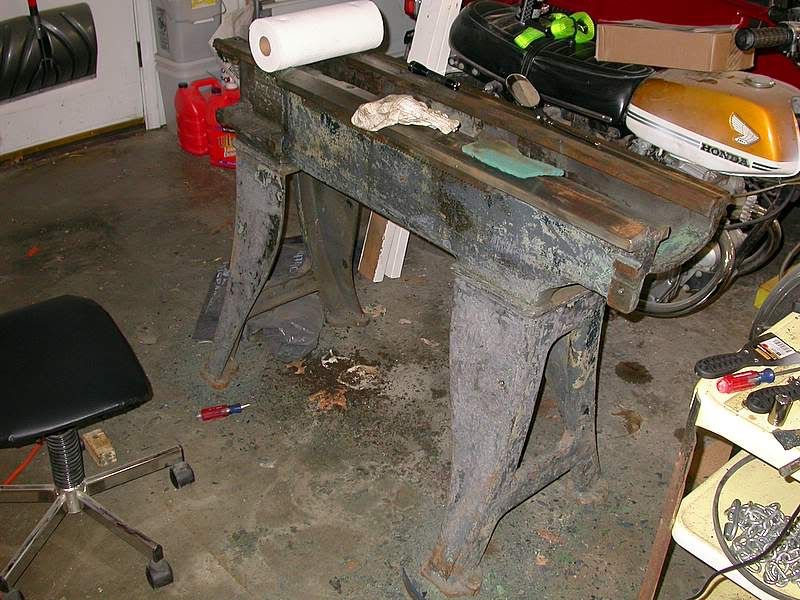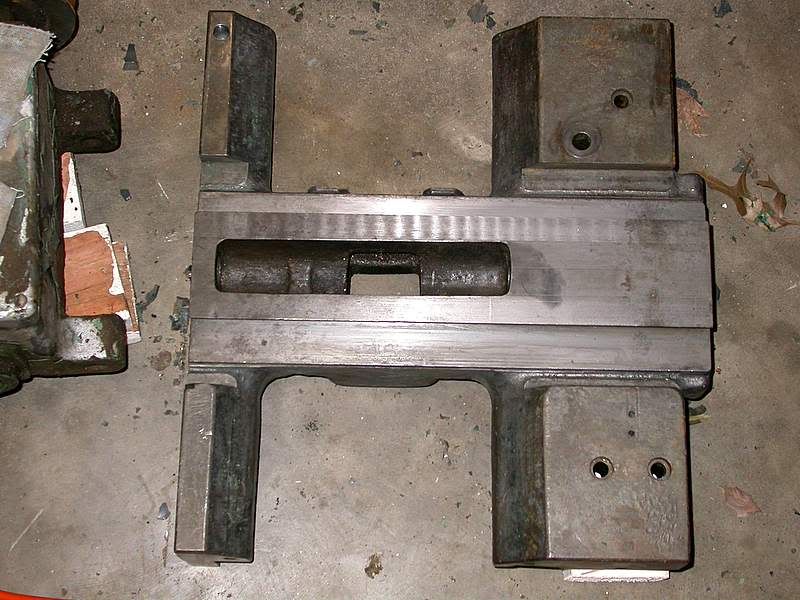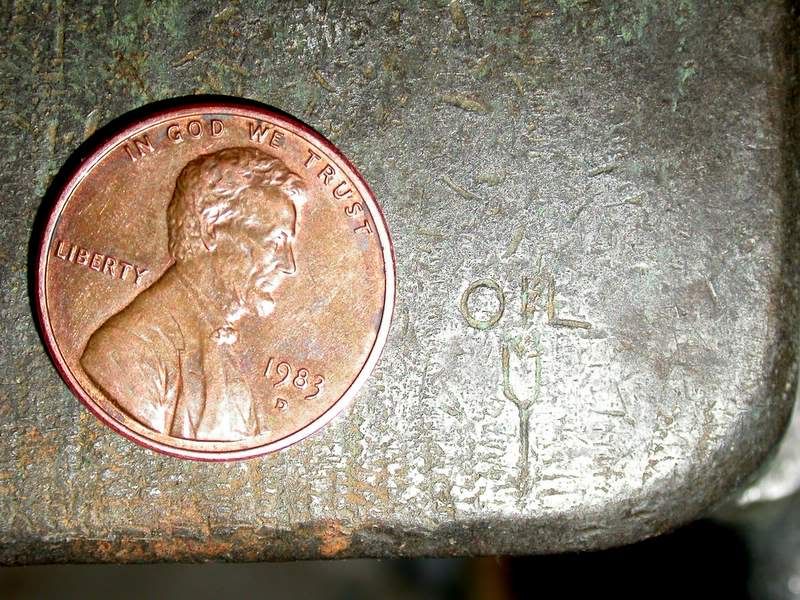Stripping the lathe
Currently, I'm in the middle of scraping and stripping the paint off of the lathe. There appears to be 3 or 4 coats of paint on it. The outer grey layer is flaking off in parts. Under that is a green layer. Below that is a blue layer. Below the blue layer there's some white filler, and then more grey paint. Because of the filler, I'm not sure if the original color was blue or grey. It seems strange that if it was repainted from grey to blue that they would add filler first.
I'm using various methods to strip the paint. For some of the smaller items, especially the ones that are steel and not cast iron, I'm setting them in a plastic tub of laquer thinner. After a good soak, I can usually easily scrape off a layer or two of paint. I did put one cast iron piece in the laquer thinner, but in addition to the paint, it stripped off the filler. So, now the casting is a little rough. You can kind of see it in the photo below:

I'm not sure if I'll put filler back on this piece, it's hidden under a cover, so no one will really see it.
The headstock has been stripped with a putty knife, a wire wheel in an angle grinder, and some paint stripper. I think the putty knife is the best way to go. The wire wheel left some scratch marks on the headstock. The paint stripper took off more filler than I really wanted to. So, I think I'm going to settle for just getting the loose paint off, giving it a sanding to smooth things out, and then painting it. It's mostly done, as seen in the picture below:

The lathe bed and legs are coming along pretty well. There's a lot of large flat spots, so it's easy to make quick progress. I'm going to scrape as much of the legs and bed as I can with them together, then I'll take them apart and finish the stripping. I'm undecided on how much I want to clean and paint on the inside of the bed. It's pretty griming and oily, and there's not a real good way to get in and scrape it all off. So, I'm tempted to leave it as it is, maybe just scrape off all the gunk that I can. But, if the rest of the lathe is all shiny, I'd hate to have that be an eye sore. However, it's going to get all grimy and oily again anyway, and I probably wouldn't wipe it down. So, that's still to be decided. Below is a photo of what it looks like now.

I've got the carriage stripped pretty well. It's ready for paint, but I need to decide how much of it I'm going to paint. Below is a picture of the carriage. This slides back and forth on the lathe bed.

On the carriage, there are spots that you need to oil occasionally. Some of these are marked with little arrows and an 'Oil' label stamped into the carriage. Below is a photo of one of these marks, with a penny shown for scale.

If I paint the top of the carriage, I don't think you'll be able to see the oil marks. I posted this question to a forum, and got varied answers. I think I'm probably going to paint it, since sanding it down to make it smooth and shiny would destroy the oil marks anyway. Click here to see the forum thread.
Below is a photo of the rest of the parts that I still have to strip. Quite a bit left to do, but I think it will look sharp when it's all done.

I'm using various methods to strip the paint. For some of the smaller items, especially the ones that are steel and not cast iron, I'm setting them in a plastic tub of laquer thinner. After a good soak, I can usually easily scrape off a layer or two of paint. I did put one cast iron piece in the laquer thinner, but in addition to the paint, it stripped off the filler. So, now the casting is a little rough. You can kind of see it in the photo below:

I'm not sure if I'll put filler back on this piece, it's hidden under a cover, so no one will really see it.
The headstock has been stripped with a putty knife, a wire wheel in an angle grinder, and some paint stripper. I think the putty knife is the best way to go. The wire wheel left some scratch marks on the headstock. The paint stripper took off more filler than I really wanted to. So, I think I'm going to settle for just getting the loose paint off, giving it a sanding to smooth things out, and then painting it. It's mostly done, as seen in the picture below:

The lathe bed and legs are coming along pretty well. There's a lot of large flat spots, so it's easy to make quick progress. I'm going to scrape as much of the legs and bed as I can with them together, then I'll take them apart and finish the stripping. I'm undecided on how much I want to clean and paint on the inside of the bed. It's pretty griming and oily, and there's not a real good way to get in and scrape it all off. So, I'm tempted to leave it as it is, maybe just scrape off all the gunk that I can. But, if the rest of the lathe is all shiny, I'd hate to have that be an eye sore. However, it's going to get all grimy and oily again anyway, and I probably wouldn't wipe it down. So, that's still to be decided. Below is a photo of what it looks like now.

I've got the carriage stripped pretty well. It's ready for paint, but I need to decide how much of it I'm going to paint. Below is a picture of the carriage. This slides back and forth on the lathe bed.

On the carriage, there are spots that you need to oil occasionally. Some of these are marked with little arrows and an 'Oil' label stamped into the carriage. Below is a photo of one of these marks, with a penny shown for scale.

If I paint the top of the carriage, I don't think you'll be able to see the oil marks. I posted this question to a forum, and got varied answers. I think I'm probably going to paint it, since sanding it down to make it smooth and shiny would destroy the oil marks anyway. Click here to see the forum thread.
Below is a photo of the rest of the parts that I still have to strip. Quite a bit left to do, but I think it will look sharp when it's all done.


<< Home